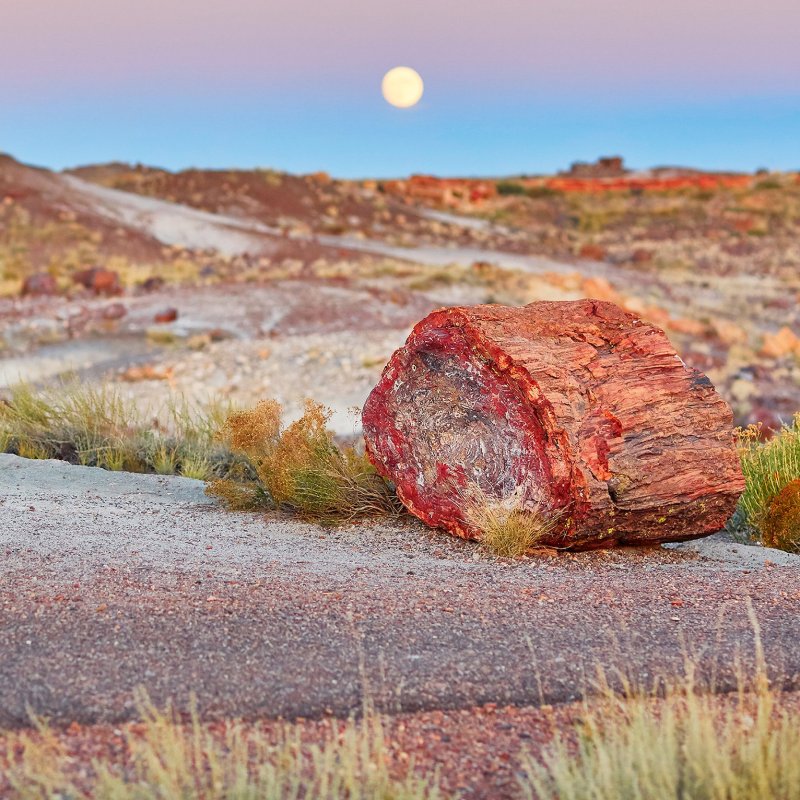
When it comes to the star power of Arizona’s parks, Petrified Forest National Park has some tough competition from its three siblings.
Videos by TravelAwaits
Saguaro National Park in southern Arizona is famous for its towering saguaro cactus — a symbol of the American West. The majesty of Monument Valley Navajo Tribal Park was memorialized in pop culture in an iconic scene from the movie Forrest Gump. And the Grand Canyon is, well, the Grand Canyon.
Still, what the Petrified Forest lacks in celebrity status, it more than makes up for in unique moonscape terrain, mysterious fossilized wood, and aura of days gone by.

Cindy Barks
In fact, don’t be surprised if a visit to Petrified Forest National Park has you thinking that the landscape is unlike anything you’ve ever encountered. And for me, that was a priceless experience!
So, if you’re in the mood for something different, slightly surreal, and largely off the tourist radar, spend a day in Arizona’s hidden gem national park.
Here’s how to make the most of your day there.

Cindy Barks
Appreciate The Painted Desert
Upon arriving at the park’s northern entrance off of Interstate 40, not far from the Arizona-New Mexico border, you will first encounter the vibrant but desolate landscape of the Painted Desert. (The park fee station is located just off the interstate.)
The 93,500-acre badland/desert region extends from the Grand Canyon area all the way east to the Petrified Forest, where the desert seems to explode into an earth-tone palette of reds, oranges, browns, grays, and lavenders.
The cracked and barren buttes seem to go on forever, and any drive through the park should include frequent stops at the available overlooks to take in the terrain. You really can’t go wrong with any of the overlooks, so I suggest stopping whenever the scenery moves you.
Or, for an up-close encounter, head out on the mile-long Painted Desert Rim Trail, accessible at the Tawa Point and Kachina Point trailheads. Although short, the hiking trail has a relatively steep grade in spots and a rough dirt-gravel surface.

Cindy Barks
Experience A Desert Oasis
For a taste of the desert’s rich history, stop by the Painted Desert Inn, a National Historic Landmark that once operated as the Stone Tree House. During the 1920s and early 1930s, the inn served as an oasis for travelers who came for a selection of Native American arts and crafts, refreshments, and a night’s stay.
Although originally built of petrified wood and native stone, the building has been covered with adobe-style stucco since a renovation by the Great Depression-era Civilian Conservation Corps in the 1930s.
These days, the inn functions as a museum that showcases the history of Route 66, the Civilian Conservation Corps, and the Painted Desert.
While it no longer offers accommodations or food service, the Painted Desert Inn still serves as an oasis for travelers ready to stretch their legs and take in some views and history.

Cindy Barks
Check The News
Two millennia before the Internet, the native Puebloan people of the area had their own version of a social network.
Newspaper Rock boasts 650 petroglyphs, or rock carvings, that were left on a series of rock formations in the Petrified Forest by the ancient Puebloan people anywhere from 600 to 2,000 years ago.
Although the meaning of the carvings is open to interpretation, modern Native American groups have identified clan or family symbols, spiritual meanings, and calendar events, according to the Petrified Forest National Park website.
As you drive the 28-mile road through the park, Newspaper Rock is among the many attractions and trailheads that are noted along the way, and it is definitely worth a stop.
Because of the instability of the hillsides, the rocks are closed to hikers, but a catwalk and overlook exist for viewing, and free spotting scopes are also available. For capturing images of the individual petroglyphs, a zoom lens will come in handy. The stop requires a short drive off the main road and a brief walk along the catwalk.

Cindy Barks
Head Down The Mother Road
A rusted old car body, dusty tumbleweeds, and a familiar highway sign etched into concrete will alert you to the significance of a portion of the park road: The old Route 66 corridor cuts through the Painted Desert, and a pullout along the road commemorates the historic route.
For decades, Route 66 was America’s Highway of Dreams — the main east-west route between Chicago and Santa Monica, California.
Arizona claims a long section of Route 66, and towns all along the route celebrate their place in travel history. Perhaps the stretch that best conjures up the combination of romance and hardship associated with the road is the section that runs through the Painted Desert.
According to a sign at the site, the Petrified Forest National Park is the only national park in the country with a section of Route 66 within its boundaries. The site is worth a quick stop for a photo opportunity and to read more about the famous road.

Cindy Barks
Hike The Blue Moonscape
Although Petrified Forest National Park is home to a number of hiking trails, if you’re going to stop at just one, I suggest you make it the Blue Mesa Trail.
The mile-long trail will not only take you into the midst of the blue-hued badlands, but it will also take you past clusters of petrified tree stumps and by informative interpretive signs that explain the geology of the area.
Of the formation of the petrified wood fossils, the park’s website explains that more than 200 million years ago, the logs that washed into an old river system were buried beneath massive amounts of sediment and debris. The wood was buried so quickly that it was protected from decay due to oxygen and organisms.
Depending on the season, you could have the Blue Mesa Trail virtually to yourself, which adds to the mysterious quality of the area. The trail, which is part pavement and part gravel, descends from the mesa into the badlands and starts with a steep grade.
The trailhead is in a somewhat remote area, about 3.5 miles off the main road. After the first steep section, the trail is fairly easy, and I spent about an hour wandering there, stopping on numerous occasions to take photos of the eerie buttes against the moody sky.

Visit A 700-Year-Old Home
Near the southern entrance to the park is the trailhead for the Agate House, a small pueblo that archaeologists believe was built about 700 years ago. The house, which is made of petrified wood, offers a glimpse into the lives of the early Puebloan people. While it stands alone on the top of a small hill, it likely was part of a much larger community, according to park information.
The 2-mile round trip begins at the Rainbow Forest Museum parking area. The trail is paved for the first half-mile, after which it transitions into a rough dirt surface. Plan on an hour or so to make the trip.

Cindy Barks
Travel Back In Time In Holbrook
After a full day of meandering along the park road, the nearby town of Holbrook, Arizona, is a convenient and fascinating spot to refresh.
Located about 20 miles northwest of the south entrance to the park, Holbrook is a somewhat frozen-in-time community that embraces its vintage feel with old signs and quirky shops. A colorful mural on a long slump-block wall in the middle of town depicts a map of Route 66, with a large You are Here arrow pointing to Arizona.
With its plentiful petrified-wood displays, its main drag that follows the original route of the historic two-lane Route 66, and its classic WigWam Motel complete with teepee-style quarters and retro cars parked out front, Holbrook is sure to take you back to the bygone days of Route 66 road trips.
If you have the time, check out the town’s museum and visitor center, which is maintained by the Navajo County Historical Society in the town’s historic courthouse. It features exhibits focusing on the Wild West and Native American art, and it also distributes a Route 66 passport to visitors who are interested in keeping track of their stops along the historic route.
To gawk at the town’s huge variety of petrified-wood souvenirs, check out one of the shops, such as Jim Gray’s Petrified Wood Co., which offers products ranging from petrified-wood chairs and tables to ashtrays and refrigerator magnets.
Interested in more of what Arizona has to offer? Here are 15 truly unique experiences to have in the Grand Canyon State.
